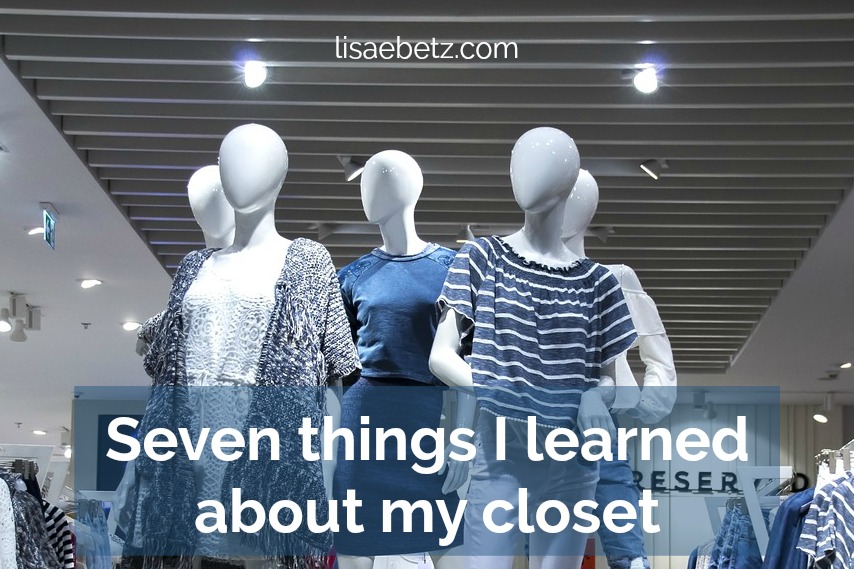
I’ve read through any number of blogs, articles, and books touting the benefits of thinning out your closet and only buying clothes that “spark joy.” Combine that with the fact I am not particularly fond of shopping and I thought I was pretty good about not wasting money on clothes and accessories.
Then I read The Curated Closet by Anuschka Rees. Since then I have been rethinking my whole philosophy on buying and owning clothes.
Let me hasten to say The Curated Closet is not a book about decluttering, or minimalism, or simple living. It’s a book about clothes and style. The subtitle is: A simple system for discovering your personal style and building your dream wardrobe.
[At this point, those who know me are wondering why on earth I was reading a book about clothes and fashion! Well, it was on a suggested reading list on a blog I follow and they had a copy in the library, so why not? But I digress…]
The book does exactly what the subtitle implies—it leads you through a series of questions to help you identify your personal style, and then gives advice on how to build your wardrobe with quality pieces that work for you.
But in the process it opens several cans of worms regarding what is in my closet now, why I buy what I do, and the disconnect between my closet and my actual clothing needs.
Here are the key points from the book that hit home with me.
- I have not been strategic about what fills my closet. It is easy to have a disconnect between what’s in our closet and the clothes that suit our actual lifestyle. For example, since I work from home I spend very little time wearing dressy clothes. Let’s say I need something dressy for 10% of my week. That means my closet should only contain 10% dressy clothes. If instead 25% of my closet is dressy, I have a disconnect between my closet and reality. (Pay special attention to this if you recently had a significant life change.)
- Not paying attention to style details results in ugly clothes. Until now I have put little thought into defining what styles (and colors, patterns,etc) work best for me. (Mindless living. Tsk tsk.) Sure I can easily spot things I would never wear, but beyond that I bought whatever seemed OK. (Maybe it looked really good on the manikin or the model in the catalog.) An hour spent trying on clothes I already own has helped me identify several style details that don’t work for me. I will not waste any more money on similar pieces!
- Owning the right clothes helps me be successful. When we know we look good in something, we feel better about ourselves. So why do I continue to buy and wear clothes that are only meh? Do I like going around town feeling meh about myself? Wouldn’t I rather wear clothes that look good and make me feel like the best version of me?
- I should shop for clothes like I shop for groceries. I have fallen into the common mistake of going clothes shopping with only a vague notion of what I should be looking for. So I browse around and come home with clothes that may be redundant or may not go with anything else I own. I would spend my clothing budget better if I shopped with a specific list of the types and colors of garments I need to fill out the holes in my wardrobe. (Intentional clothes shopping. Who knew?)
- I should shop like a tortoise, not a hare. I usually try to zip in and out of clothing stores as quickly as possible. What I should be doing is taking a few extra moments to check the quality of seams and other details. Also I should test the fit and only buy clothes that fit correctly. (How many shirts with not-quite-long-enough sleeves do I have? Sigh.)
- Cheap clothes are not a bargain. They wear out, rip, sag, or fade quicker than more expensive items because better-quality garments use higher-quality fabric and better sewing techniques that help clothes last and look good. (And I won’t even start the discussion on social justice issues.)
- Bargain clothes are not necessarily a bargain, either. Because it’s too easy to fall into the trap of thinking something is such a good bargain it won’t hurt to buy it (whether I need it or not). Sale-priced clothing is only a bargain if it’s something I would be willing to pay full price for. We should make decisions on what to buy before we look at the price, rather than the other way around.
Bonus Tip: For the intentional shopper, success is finding the right item at the right price, not coming home with bags of bargains. It’s OK to buy nothing if you can’t find exactly what you were looking for.
I hope these lessons will help you the next time you head to the store. Happy shopping!

These are really true. I like your article. I like or Really like clothes shopping. I love textures, colors, I find real pleasure in finding a classic piece with an unusual creative touch that just sets it apart. Anytime you want to shop, I would love to tag along. Always, always try on, even if you Might like it, try it All on cause it may surprise you. Even if it Probably won’t fit, I have found pieces in fabrics I love in XL, that definitely wont fit in the way the designer planned. But I wear that sweater the designer planned to come to the waist, as a tunic instead. Don’t shop under pressure. And don’t put your clothes in the dryer unless you’re getting out wrinkles, wash them inside out, hang them up (not in the sun). Happy Shopping!
Thanks for the offer. I may work up the courage to take you up on it sometime. And I love the advice about wearing something in a way other than the original plan.